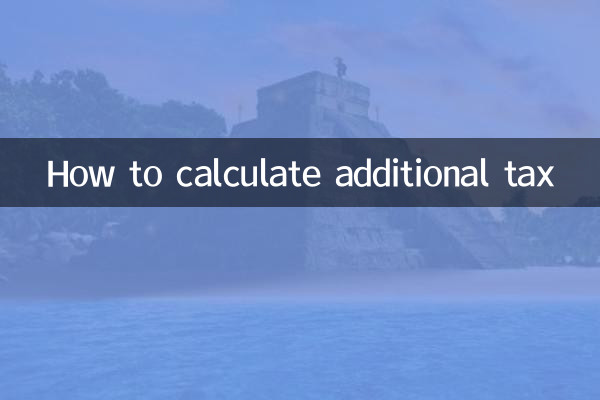How to calculate additional tax
Recently, the calculation method of additional tax has become one of the hot topics on the Internet. Both corporate financial personnel and ordinary taxpayers have a strong interest in the specific calculation method of additional tax. This article will combine hot topics and hot content in the past 10 days, analyze the calculation method of surcharge in detail, and provide structured data to help readers better understand.
1. Basic concepts of additional tax

Additional tax refers to an additional tax levied on the basis of the main tax, usually for specific purposes or to supplement fiscal revenue. Common surtaxes include urban maintenance and construction tax, education surcharge, local education surcharge, etc. The calculation of these additional taxes is usually linked to the main tax (such as value-added tax, consumption tax).
2. Calculation formula of additional tax
The formula for calculating additional tax is usually as follows:
| Additional tax type | Calculation formula | tax rate |
|---|---|---|
| urban maintenance and construction tax | Main tax amount × tax rate | 7% (urban areas), 5% (counties, towns), 1% (others) |
| Education fee surcharge | Main tax amount × tax rate | 3% |
| local education supplement | Main tax amount × tax rate | 2% |
3. Specific calculation examples of additional tax
Assuming that a company pays RMB 10,000 in value-added tax that month and is located in an urban area, its additional tax is calculated as follows:
| Additional tax type | Calculation process | Amount of tax |
|---|---|---|
| urban maintenance and construction tax | 10,000 × 7% | 700 yuan |
| Education fee surcharge | 10,000 × 3% | 300 yuan |
| local education supplement | 10,000 × 2% | 200 yuan |
4. Time for payment of additional tax
The additional tax is usually paid at the same time as the main tax. For example, an enterprise that pays VAT on a monthly basis will also pay its surtax on a monthly basis; an enterprise that pays its VAT on a quarterly basis will also pay its surtax on a quarterly basis. The specific payment time is subject to the regulations of the local tax authorities.
5. Preferential policies for additional tax
In recent years, the state has introduced a series of preferential surtax policies to reduce the burden on enterprises. For example:
| Policy content | Applicable objects | Execution period |
|---|---|---|
| Education surcharge for small and micro enterprises reduced by half | Small and micro enterprises with monthly sales not exceeding 100,000 yuan | Effective for a long time |
| Additional tax reduction and exemption during epidemic prevention and control period | Industries greatly affected by the epidemic | January 2020-December 2022 |
6. Frequently Asked Questions about Additional Tax
1.Is the additional tax deductible?Additional taxes are generally not deductible but may be deducted as an expense before corporate income tax.
2.Will the surtax rate be adjusted?The rate of additional tax is set by local governments in accordance with national regulations and is adjusted less frequently, but changes in local policies need to be paid attention to.
3.What is the method for reporting additional tax?Additional tax is usually declared together with the main tax and submitted through the electronic tax bureau or tax service office.
7. Summary
Although the calculation of additional tax is relatively simple, the specific tax rates and preferential policies involved require taxpayers to carefully understand. Through the structured data display in this article, I believe readers will have a clearer understanding of the calculation method of additional tax. In actual operations, it is recommended to consult professional tax personnel or tax authorities to ensure compliance with payment regulations.

check the details

check the details